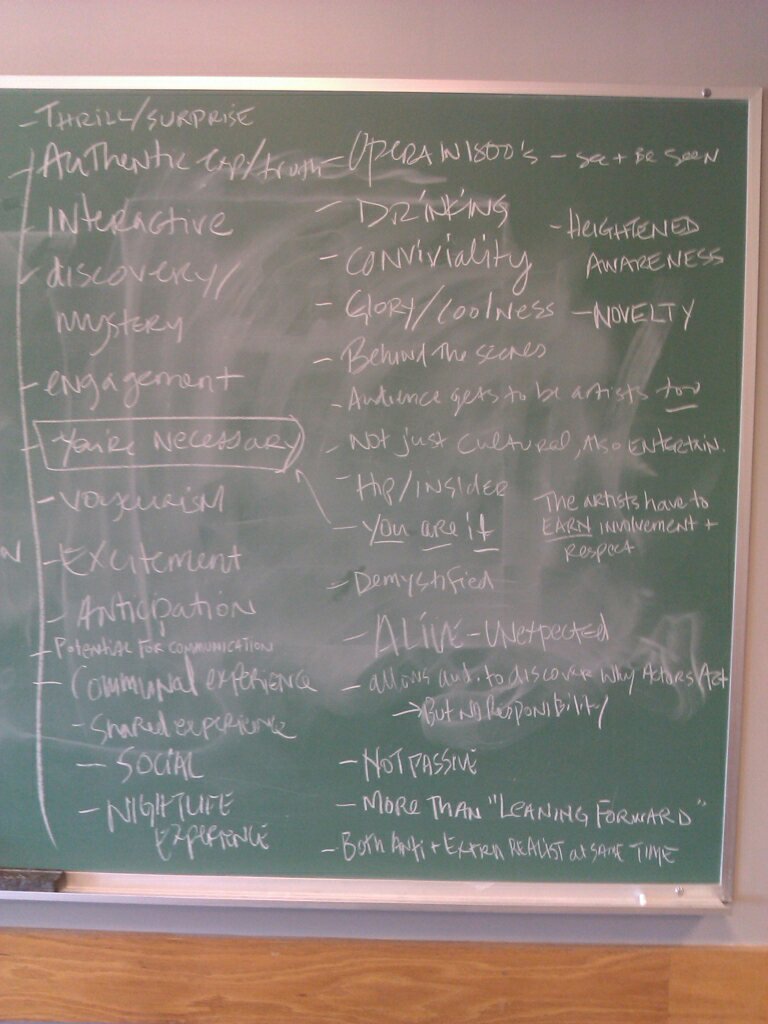Over the past week, Mike Daisey's critically heralded monologe, The Agony and the Ecstasy of Steve Jobs (TATESJ), has had a change of fortune, and has prompted a backlash in both the theatre and journalism worlds. (Full disclosure, Mike is a friend, and watching this unfold has been rough.)
The barest attempt at a backstory of events: Concurrent with Mike's effort to bring attention to the plight of Chinese workers in Apple factories, the mainstream media was also digging into the story. (A huge investigative series appeared in The New York Times, for instance.)
Ira Glass of This American Life (TAL) saw TATESJ and asked Mike to adapt an excerpt for a full-episode broadcast, which he did in a piece called Mr. Daisey and the Apple Factory. It was one of their most popular episodes ever (888,000 downlads, and 206,000 streams). It brought enormous amounts of new attention to Daisey's work, and to TATESJ in particular. Daisey was invited to appear in various major media outlets to talk about his experiences in the Foxconn plant (as he detailed them in TATESJ), including Bill Maher's show, Nightline, and the Op-Ed page of The NYT.
TAL, which holds itself to high journalistic standards, did call out certain moments of the original broadcast for lack of factual corroboration. That was on January 6th. On March 15th, TAL dropped the bombshell that they were retracting the episode -- an unprecedented move on their part -- because, as Glass said, "Daisey lied to me and to This American Life producer Brian Reed during the fact checking we did on the story, before it was broadcast. That doesn't excuse the fact that we never should've put this on the air. In the end, this was our mistake." It also put together an entirely new episode detailing all the factual problems, and featuring interviews with Daisey about his motives.
Then all hell broke loose.
I'll link below to a selection of the vast amount of coverage this has sparked -- much of which is outraged, some of which tries to probe the assumptions about fact-based-art and where our moral/ethical responsibilities rest on that spectrum. Most interesting to me is the distinction between theatre and journalism, and what happens when the artist steps off the stage.
(I'll add that Daisey has made a point over the years of picking extended and detailed fights with critics, sometimes reveling in bringing their perceived stupidity to light. A few of the the dancing-on-the-grave flavored posts from the past few days feel mildy influenced by this.)
I feel so conflicted. I believe that art does not have a responsibility to fact. But I also feel like when it leaves the stage, there are other expectations that can't be ignored. As James Carter notes, "Mike has a two-line disclaimer in the Playbill for The Agony and Ecstasy of Steve Jobs in all caps: THIS IS A WORK OF NONFICTION. SOME NAMES AND IDENTITIES HAVE BEEN CHANGED TO PROTECT THE SOURCES." The accusations against TATESJ go far beyond changing names to protect sources.
{Sidebar: I am particularly miffed at one of Ira Glass' points in his confrontation with Daisey, and I take issue with Glass totally separately from the circumstances of TATESJ. I otherwise think Glass is pretty smart, but in the retraction episode from this past weekend, he says the following: "I feel like I have the normal worldview. The normal worldview is somebody stands on stage and says ‘this happened to me,’ I think it happened to them, unless it’s clearly labeled as ‘here’s a work of fiction.’" IS this the normal worldview? Someone on stage in a theatrical work says "this happened to me" and you take that as unmitigated truth? REALLY? ...For a really great example of this exact artistic issue, see Young Jean Lee's We're Gonna Die. Lots of personal monologues, probably lots of people who thought when she said they're true that they happened to her. But they didn't. Does that make her show a lie? No, I don't buy that.}
...Anyway.
Here are the links. I'm sure there will be more to come.
From Mke Daisey:
Mike's first response
Mike's second response -- audio from the prologue he added to the final show of the Public Theater run on March 18th.
Mike's third response
Mike's talk in Georgetown on March 20th -- his first long-form response
From the Theatre:
Polly Carl, editor of HowlRound.com, and part of the American Voices New Play Institute
Howard Sherman, former director of the American Theatre Wing and current arts pundit
Alli Houseworth, former Marketing Director of Woolly Mammoth Theatre, which developed TATESJ
Holly Hughes, a lesbian performance artist and member of the "NEA Four"
From Popular Media Outlets:
Mark Oppenheimer, in Salon.com
The staff of Salon.com
From Gawker Media
James Fallows in the Atlantic
NYT's David Carr on Theatre Disguised as Journalism
Transmedia on Daisey
Apple's Steve Wozniak on the media explosion
AND SOME VERY CURRENT EVENTS IN RESPONSE:
- A theatre company in Louisiana that had scheduled a run of TATESJ after Daisey had released the script, has to figure out what to do in the wake of the TAL retraction.
- Theatre artists in New York put together an emergency panel called Truth in Theatre for March 22nd at the Public Theatre, which just closed a run of TATESJ on the 18th. (PS: That link just above is really worth reading.)

